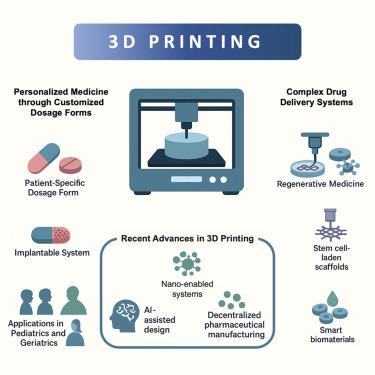Innovative applications of 3D printing in personalized medicine and complex drug delivery systems
IF 4.1
2区 综合性期刊
Q1 MULTIDISCIPLINARY SCIENCES
引用次数: 0
Abstract
Three-dimensional (3D) printing, or additive manufacturing, is transforming pharmaceutical and biomedical fields by enabling personalized medicine. This review highlights advances in 3D printing for customized drug delivery systems, including patient-specific dosage forms, multidrug polypills, and implantable devices that improve adherence and therapeutic outcomes—especially for pediatric and geriatric populations. The intersection of 3D printing with regenerative medicine is also explored, focusing on bioprinting technologies, stem cell-laden scaffolds, and smart biomaterials such as hydrogels and bioinks for localized therapy and tissue repair. These strategies reflect an expanded vision of personalized medicine, merging individualized pharmacotherapy with tissue engineering. Additionally, the review discusses the integration of artificial intelligence, nano-enabled platforms, and decentralized pharmaceutical manufacturing to accelerate development and access. Key regulatory and technical challenges are outlined, along with future directions to promote the clinical translation and scalability of 3D-printed pharmaceutical and regenerative systems.

3D打印在个性化医疗和复杂药物输送系统中的创新应用
三维(3D)打印,或增材制造,通过实现个性化医疗正在改变制药和生物医学领域。这篇综述重点介绍了3D打印在定制药物输送系统方面的进展,包括针对患者的特定剂型、多药丸剂和可植入设备,这些设备可改善依从性和治疗结果,特别是针对儿科和老年人群。还探讨了3D打印与再生医学的交叉,重点是生物打印技术,干细胞负载支架,以及用于局部治疗和组织修复的智能生物材料,如水凝胶和生物墨水。这些策略反映了个性化医疗的扩展愿景,将个性化药物治疗与组织工程相结合。此外,该综述还讨论了人工智能、纳米平台和分散制药制造的集成,以加速开发和获取。概述了关键的监管和技术挑战,以及促进3d打印制药和再生系统的临床转化和可扩展性的未来方向。
本文章由计算机程序翻译,如有差异,请以英文原文为准。
求助全文
约1分钟内获得全文
求助全文
来源期刊

iScience
Multidisciplinary-Multidisciplinary
CiteScore
7.20
自引率
1.70%
发文量
1972
审稿时长
6 weeks
期刊介绍:
Science has many big remaining questions. To address them, we will need to work collaboratively and across disciplines. The goal of iScience is to help fuel that type of interdisciplinary thinking. iScience is a new open-access journal from Cell Press that provides a platform for original research in the life, physical, and earth sciences. The primary criterion for publication in iScience is a significant contribution to a relevant field combined with robust results and underlying methodology. The advances appearing in iScience include both fundamental and applied investigations across this interdisciplinary range of topic areas. To support transparency in scientific investigation, we are happy to consider replication studies and papers that describe negative results.
We know you want your work to be published quickly and to be widely visible within your community and beyond. With the strong international reputation of Cell Press behind it, publication in iScience will help your work garner the attention and recognition it merits. Like all Cell Press journals, iScience prioritizes rapid publication. Our editorial team pays special attention to high-quality author service and to efficient, clear-cut decisions based on the information available within the manuscript. iScience taps into the expertise across Cell Press journals and selected partners to inform our editorial decisions and help publish your science in a timely and seamless way.
 求助内容:
求助内容: 应助结果提醒方式:
应助结果提醒方式:


